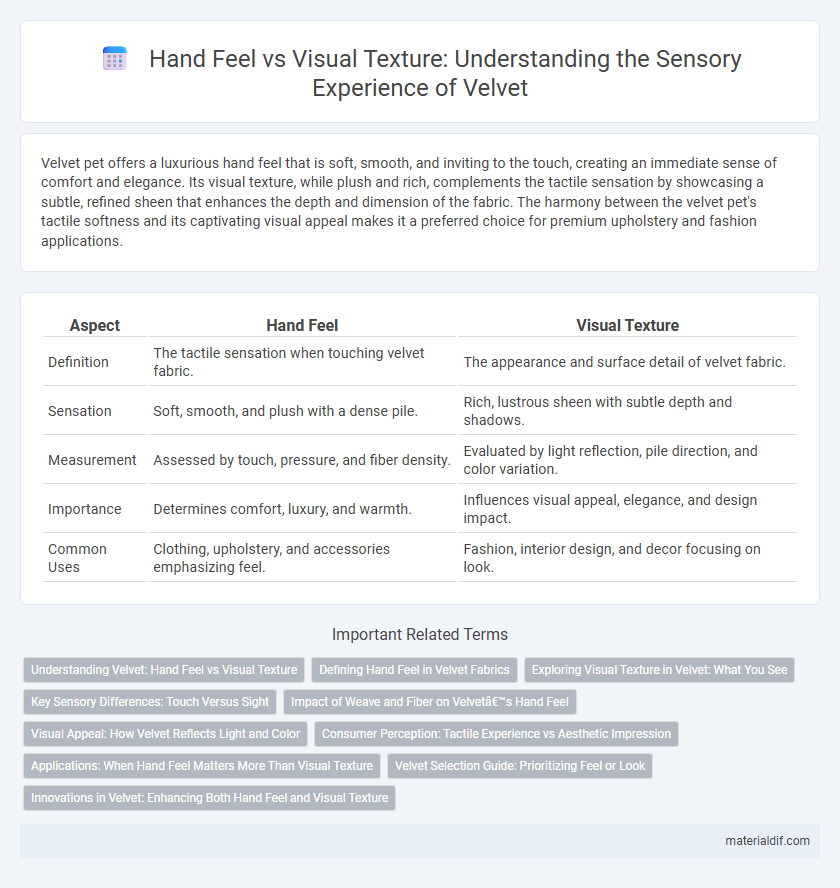Velvet pet offers a luxurious hand feel that is soft, smooth, and inviting to the touch, creating an immediate sense of comfort and elegance. Its visual texture, while plush and rich, complements the tactile sensation by showcasing a subtle, refined sheen that enhances the depth and dimension of the fabric. The harmony between the velvet pet's tactile softness and its captivating visual appeal makes it a preferred choice for premium upholstery and fashion applications.
Table of Comparison
| Aspect | Hand Feel | Visual Texture |
|---|---|---|
| Definition | The tactile sensation when touching velvet fabric. | The appearance and surface detail of velvet fabric. |
| Sensation | Soft, smooth, and plush with a dense pile. | Rich, lustrous sheen with subtle depth and shadows. |
| Measurement | Assessed by touch, pressure, and fiber density. | Evaluated by light reflection, pile direction, and color variation. |
| Importance | Determines comfort, luxury, and warmth. | Influences visual appeal, elegance, and design impact. |
| Common Uses | Clothing, upholstery, and accessories emphasizing feel. | Fashion, interior design, and decor focusing on look. |
Understanding Velvet: Hand Feel vs Visual Texture
Velvet is renowned for its rich hand feel, characterized by a soft, plush surface created by densely packed fibers that offer a luxurious tactile experience. The visual texture of velvet reveals a unique sheen and depth due to the way light reflects off its cut pile, creating variations in color and shadow. Understanding velvet requires recognizing that its hand feel emphasizes softness and warmth, while its visual texture highlights the fabric's opulence and dynamic surface appearance.
Defining Hand Feel in Velvet Fabrics
Hand feel in velvet fabrics refers to the tactile sensation experienced when touching the material, characterized by its softness, smoothness, and plushness. It measures how the dense pile and fiber composition influence comfort and luxury, distinct from visual texture, which concerns the fabric's appearance and sheen. Evaluating hand feel involves assessing fiber type, pile height, and fabric weight, each contributing to the velvet's overall sensory quality.
Exploring Visual Texture in Velvet: What You See
Visual texture in velvet reveals its rich pile and depth through the interplay of light and shadow, creating a luxurious and dynamic surface. The fabric's characteristic sheen enhances patterns and color variations, making velvet visually appealing beyond its tactile softness. Observing velvet's visual texture helps in distinguishing quality and craftsmanship in textile design.
Key Sensory Differences: Touch Versus Sight
Velvet offers a distinct hand feel characterized by its soft, plush surface created by dense fiber pile, enhancing tactile comfort and warmth. The visual texture appears rich and lustrous, with light reflecting variably across its smooth nap, creating depth and dimension. Key sensory differences arise as the hand feel emphasizes softness and cushioning, while visual texture highlights luxurious sheen and color intensity.
Impact of Weave and Fiber on Velvet’s Hand Feel
The hand feel of velvet is significantly influenced by both its weave and fiber composition, with silk fibers creating a smoother, more luxurious touch compared to cotton or synthetic blends. A dense, tightly woven structure enhances the plushness and softness, providing a deeper pile that contributes to velvet's characteristic rich tactile sensation. Variations in weave tension and fiber fineness directly affect how velvet feels to the touch, balancing between softness, weight, and durability.
Visual Appeal: How Velvet Reflects Light and Color
Velvet's visual texture is characterized by its unique pile construction, which creates depth and dimension through light reflection. The fabric's dense fibers catch and reflect light differently depending on the angle, enhancing color richness and producing subtle shading effects. This dynamic interplay between light and velvet enhances its luxurious appeal, making it a favored choice in fashion and interior design for visually striking surfaces.
Consumer Perception: Tactile Experience vs Aesthetic Impression
Consumers often prioritize hand feel when evaluating velvet, as the tactile softness and smoothness directly influence comfort and luxury perception. Visual texture enhances aesthetic appeal, showcasing the fabric's rich pile and subtle sheen, which can signal opulence and style to the observer. The interplay between tactile experience and aesthetic impression ultimately shapes consumer preference and perceived value in velvet products.
Applications: When Hand Feel Matters More Than Visual Texture
In luxury fashion and upholstery, hand feel often outweighs visual texture because tactile comfort directly influences user experience and satisfaction. Products like high-end velvet garments and premium furniture prioritize a soft, smooth hand feel to convey quality and enhance wearability or comfort. This emphasis on tactile sensation supports applications where prolonged skin contact and sensory perception define value more than mere appearance.
Velvet Selection Guide: Prioritizing Feel or Look
Velvet selection requires balancing hand feel and visual texture, with the tactile softness and rich pile height influencing comfort and luxury perception. Fabrics with longer, denser fibers offer a plush, smooth sensation, while variations in weave and finish impact sheen and pattern visibility, enhancing aesthetic appeal. Prioritizing hand feel suits upholstery and clothing worn close to skin, whereas visual texture dominance benefits decorative purposes showcasing depth and intricate design.
Innovations in Velvet: Enhancing Both Hand Feel and Visual Texture
Recent innovations in velvet fabric integrate advanced weaving techniques and nano-fiber technology, significantly enhancing both hand feel and visual texture. These developments create a softer, more luxurious touch while maintaining a rich, dynamic surface appearance. Enhanced pile density and innovative dyeing processes also contribute to velvet's improved tactile comfort and vivid, enduring colors.
Hand Feel vs Visual Texture Infographic

 materialdif.com
materialdif.com